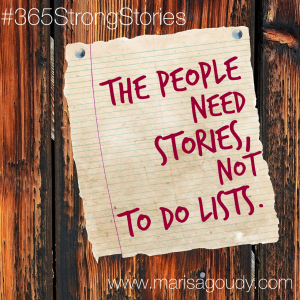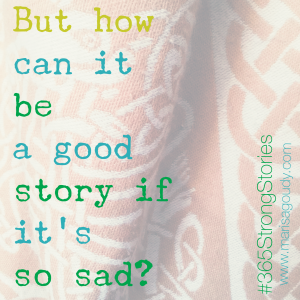
BLOG
“Share what is vulnerable, not what is intimate.”
Share what is vulnerable, not what is intimate - Brene Brown | #365StrongStories by Marisa Goudy | writing coach for therapists, coaches, healers, thought leaders
"I don't share anything until my feelings and growth aren't still dependent on it."
- Brené Brown
A slide with this quote on it lit up the chat box during the recent Story Triangle webinar.
We were deep into our exploration of what makes stories work and what makes them fall flat. At this point in the class, we were talking about how a story loses its balance when you, the writer, get lost in the details of your own story.
It's almost always a struggle, deciding what story elements add depth and what's going too deep.
As I hit publish, I’m grateful to have Brené to look to when I worry “Is this TMI?
After all, when writing is both your private, emotional processing tool and the way you communicate publicly and professionally, it can feel like a tightrope walk.
How do you tell the difference between a rich, compelling story and simply pouring out your guts?
Again, there’s a Brené quote for that. (Isn’t there a BB line for just about everything related to relationships and speaking truth?)
“Share what is vulnerable, not what is intimate.”
Sharing vulnerable stories reveals your humanity and creates connections.

Pouring out the intimate details into a public space where people who aren’t prequalified to hold you in all your glorious imperfection…
At best, you get no response at all. At worst, potential clients judge what they do not understand, turn away, and seek out someone who they believe is more in control of their sh*t.
So how do you tell the difference between the vulnerable stories that are ready for the spotlight and intimacies that need to be held in reserve?
Check in with your own process. Can you say “I’ve healed this” and feel you’re being completely honest with yourself?
Decide why you’re telling the story. Do you have something to teach based on your experiences or do you just need someone to be your witness?
If your answer to #1 is “I haven’t healed this yet,” that’s great. Pull out your journal, call a friend, make sure your on time for your next therapy or healing session.
Do. Not. Blog. This. (Yet.)
If you your answer to #2 is “I need a witness,” embrace this beautifully human moment. Everyone needs to be seen, heard, and understood.” Yes, be fully present in your need to be seen, but do so with the people you know and trust - not your professional audience.
The only inspirational quote you need as a writer & entrepreneur
 Nobel prize winning poet and Irishman Seamus Heaney's quote is scrawled on a post-it above my computer. It fights for space with love notes from my daughter and memos about my many accounting goofs, but it's the only inspirational line I keep in my line of sight.
Nobel prize winning poet and Irishman Seamus Heaney's quote is scrawled on a post-it above my computer. It fights for space with love notes from my daughter and memos about my many accounting goofs, but it's the only inspirational line I keep in my line of sight.
"If you have the words, there's always a chance you'll find the way" is the only guidance I need because it speaks to heart of my work as a writer and as an entrepreneur.
These words are going to open my Story Triangle webinar that's set for 1 PM ET tomorrow (Tuesday, April 5).
Even in our multimedia world where video talks and images sell, words are always at the heart of our work. We need the words to build the narratives that change minds and touch hearts.
We tell stories to find a way - a way to connect, to inspire, to build a business and a livelihood, and, ultimately to make this world more beautiful, bearable, and bold.
Please join me tomorrow. I'd be honored to show you a new way to use your words and stories.
Storytelling Is About Relationships
 Is this your fantasy too?
You get to be the person with the space, the time, and the luxury to simply write. Uninterrupted days are lavished on your own ideas without a care for the reader or the marketplace.
Is this your fantasy too?
You get to be the person with the space, the time, and the luxury to simply write. Uninterrupted days are lavished on your own ideas without a care for the reader or the marketplace.
Well, that is certainly my fantasy, but we all know I have an incurable addiction to words and sentences. Maybe your fantasy is that you'd never have to write another word again! Maybe you pray that you'll be able to build a solo business or practice without creating online content and telling your brand's story.
Whether your a born writer or you're someone who needs to be tied to the keyboard to get the blogging done, we all need a reality check:
Stories depend on relationships and relationships depends on story.
Next week, in the Connect with Readers & Clients: Discover the Story Triangle we're going to explore how stories build relationships and how stories depend on relationships.
We go a little in today's Facebook live video (below). Be sure to sign up for the free webinar to learn how to make these relationships work in your own writing. Save my seat!
The People Need Stories, Not To Do Lists
 The difference between telling a strong story and writing “just another blog post”
The difference between telling a strong story and writing “just another blog post”
There are million different ways to approach a topic. Say you wanted to write about how to talk with your partner about a struggles a creative entrepreneur.
You could use the good old “people love list posts” approach:
Seven ways you “should” approach the situation including “make a spreadsheet that he can understand!” and “make sure everyone is well-rested and ready to fully engage in the conversation.”
If your readers are worrying about how to get their partner to be more supportive of a business venture, they just might come away with a tip that helps them along.
But then there’s the storytelling approach:
It’s one a.m. when she gets to bed. She’s chilled from sitting at the computer for so long and feels so grateful when he entangles his sleep warmed limbs with hers. Visions of Facebook ads and YouTube clips swim before her eyes as she tries desperately to sleep. The kids will be up soon and there’s so much more work to do to get this new course launched.
He knows the pattern of her breath. He knows it doesn’t mean anything good. “Did you get everything done?” he asks. When she snorts, he asks, “Did you get at least one thing done? Are you upset?
“Yes. And yes.” She starts to cry because finishing up a LeadPage doesn’t feel like much when the to do list stretches across so many notebook pages.
She is not ok. She is tired and she is scared and she is so desperate for all of her work to pay off.
It would have been easy to mumble “it’s all good” and roll over to feed her fears into the lonely darkness. Instead, she chose to be honest. She chose to speak her truth and ask her husband for the kind of help that only he can give - to listen to her in the darkness and make the world feel safe again.
Though they’ll both be exhausted in the morning, there’s one less brick in the wall between them. There’s space for sunshine and support and connection to flow in their marriage, in her business, and in their bank account.
This is why storytelling works
Because it’s a story, the reader connects with you in a real way that builds trust. They get drawn in by the emotion. Even if they’re not looking for “quick and easy tips for having tough conversations with your spouse about your business,” people who understand the challenges of entrepreneurship will be drawn in.
Stories are like giant magnets for the brain - people want to be invited into the room, into the conflict, and into the resolution. A story like this one shows them they’re not alone and exposes the other side of “grow your six figure online business” sales pitches.
How to make storytelling work for you, your audience, and your business
Is that my story above? Well, I can tell you that I am launching a new course and I’m pretty sleepy today…
That’s not the point of all this, though. My goal is to help you understand that stories are what connect you with your readers and with your potential clients.
We dive deep into why we need stories and list posts in the Connect With Your Readers & Clients: Discover the Story Triangle webinar. The recording will be available through Monday, April 11.
“But how can it be a good story if it’s so sad?”
 “But how can it be a good story if it’s so sad?”
It was hard to make out the words because she was burying her face in my belly, but I understood exactly what she meant.
“But how can it be a good story if it’s so sad?”
It was hard to make out the words because she was burying her face in my belly, but I understood exactly what she meant.
It seems impossible that we could love something that awoke our darkest fears and left us in a weeping puddle. It seems like madness that we would subject our children to such pain. But, like countless parents since the beginning of humanity, I’d merrily offered up some entertainment that would terrify as much as it delighted.
Within thirty seconds I figured out the basic plot of The Song of the Sea, the fantastical animated Irish film about the silkies - those seals who came to shore and became human women for a time. This is another mystery of story - why would we devote so much time and lavish so much emotion on something so predictable?
Well, I could predict that the pregnant mother singing so sweetly to her young son wasn’t going to make it into scene two. What I couldn’t predict was that wondrous journey and the magical images that would pull us along for the next hour and more.
These tales of otherworldly parents and children on a quest for happiness in the real world pretty much always end up the same. When I kept reassuring my six year-old that it was all going to end well I was pretty sure I was telling enough of the truth. After all, everyone was smiling in a sweet family tableau at the end. But my daughter couldn’t see all that through her tears.
While the credits rolled I reminded her of how much she’d loved the rest of the movie. I told her to think of how the children were so happy with their daddy even if their mama was off with the other fairyfolk in the sea. Most challenging of all, I tried to make her understand that the best stories are those that open our hearts to experience something powerful and meaningful. Considering that now, two days after that initial viewing, she wants to see it again, I can only assume she heard me. More likely, it’s just a testament to our devotion to stories that transform our everyday view of the world and make us feel.

